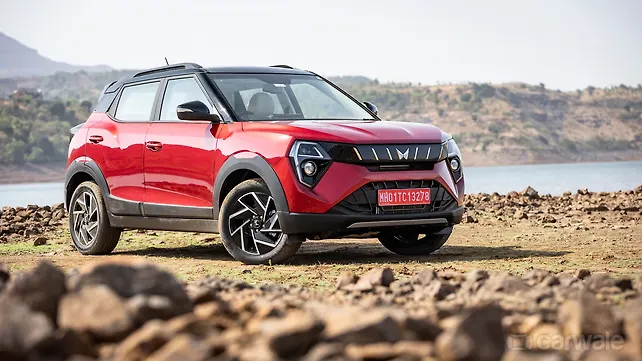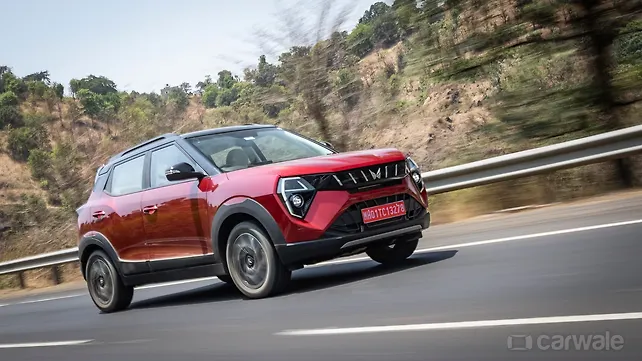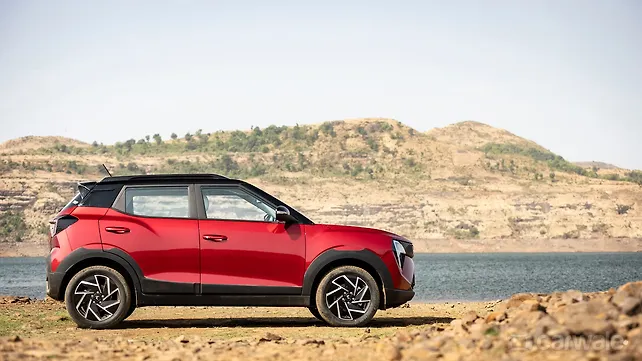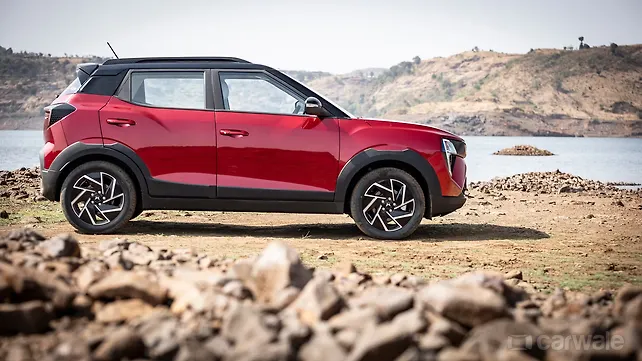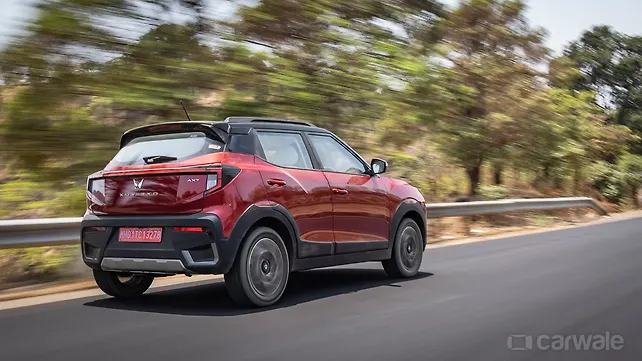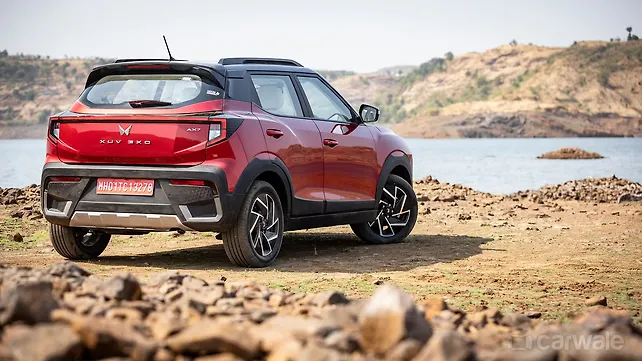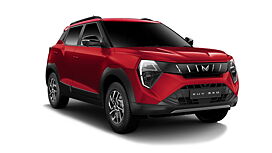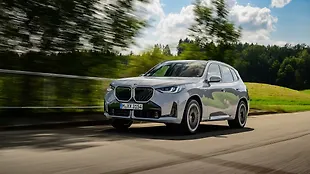Why would I buy it?
- New-age features
- Torquey engine
- Great pricing
Why would I avoid it?
- Polarising looks
- Light interiors difficult to maintain
What is it?
8 / 10
The Mahindra XUV3XO is a refreshed version of its predecessor - the XUV300. The variants also follow a new nomenclature, while the compact SUV gets new styling, additional features, and more. We delve into these details finding out if the changes make the XUV3XO better than the XUV300.

First up, the exterior changes. The XUV 3XO's redesigned fascia featuring new LED DRLs and headlamps sports a blacked-out grille with chrome accents and the new Mahindra logo. The silhouette is similar but it rides on upsized 17-inch dual-tone alloys that fill the wheel wells better. Here, the design is not up to our liking and the carved-out wheel arches look odd too. Then, the sub-four metre SUV also gets new C-shaped LED taillights connected by an LED light bar as is the norm in this segment. Besides, the new colour options add some flare to its otherwise overdone exterior.

How is it on the inside?
8 / 10

Step inside, and the layout will feel similar to that of the XUV300 with new equipment from the XUV400 in its last update. So, overall, the front visibility is good, rear visibility is narrow, leatherette upholstery's quality feels upmarket, soft-touch upper dashboard looks and feels premium, there's good space inside with supportive seats, and it's an ergonomically sound cabin. However, the buttons on the dash (hazard, steering mode) are still flimsy, piano black accents are fingerprint magnets, and the ivory interior will be prone to soiling. Also, the seats are perforated but lack a ventilated function.

Nonetheless, the second row is commendable with a generous amount of legroom, adequate headroom, and manageable shoulder room for even three occupants. The flat floor, bigger sunroof, and rear AC vents make the area feel more spacious and airy. The backrest is nicely reclined for comfort and gets a 60-40 split, which will be useful for expanding the new 364-litre space that's made deeper this time around. Also, the loading area feels the same as that of the XUV300, though with limited space to stack big bags on top of each other even without a parcel tray. We couldn't measure it but plan to do that soon.

Now, the additional features include the most promising changes, namely the dual 10.25-inch screens for the infotainment display and the digital instrument cluster. Yes, these are from the XUV4OO and add appeal and functionality to the 3XO with a crisp and smooth UI. Even maps (MapMyIndia) are integrated into the instrument cluster in line with its arch-rival, the Tata Nexon which uses Google maps.

The lower section of the AC panel in the 3XO is updated with dual-zone automatic climate control and a wireless charger. Other welcome additions are a Harman Kardon music system with six speakers, cooled glove box, and an auto-dimming IRVM. It also gets the brand's AdrenoX Connect with in-built Alexa, Android Auto, and Apple CarPlay connectivity that will be activated later this month. The SUV's new smartphone functionality enables owners to remotely control functions such as infotainment, air-conditioning, and locking or unlocking the doors.

On the safety front, it gets six airbags, ESC, all three-point seat belts with reminders, rear parking sensors, all-disc brakes, traction control with brake assist, and ISOFIX mounts even in the base variant. Higher up the line-up, there's hill hold and descent control, TPMS, and front sensors. The 'L' variants, namely the AX7 Luxury and AX5 Luxury get Level 2 ADAS, 360-degree camera, and an electronic parking brake with auto hold in addition to all the other features.

How is it to drive?
8 / 10

The XUV 3XO carries forward the 1.2-litre turbo-petrol and 1.5-litre turbo-diesel engines from the XUV300. Currently, Mahindra offers a choice of a six-speed manual or six-speed automatic transmission on all engines, eliminating the issue of the lack of an AT and adding good convenience to the buyers. We are sampling the diesel manual here and it has a claimed mileage of 20.6kmpl. The cabin is quiet with the engine coming to life without much noise, the vibes are negligible, and the motor feels refined at all times. However, when you rev up in a lower gear, it becomes audible. Nevertheless, hardly any vibrations crept into the cabin.

The 1.5-litre four-cylinder mill is tuned to churn 115bhp at 3,750rpm and its peak torque output is rated at 300Nm at 1,500rpm. The car pulls from 800rpm at low speeds and will take its own sweet time. Better to keep it above 1,000rpm. Nevertheless, more than the low-end performance, the 3XO will impress drivers who exploit its mid-range performance. Below 2,000rpm, there's a noticeable lag, but post this there's a strong surge of torque moving the car ahead with a strong pull. Barring stop-and-go traffic, the long clutch travel and long gear throws won't be an issue as the 3XO can pull from a higher gear thanks to the higher torque. That said, you'll be reminded of the lack of a dead pedal often. In sixth gear, it does 80kmph at 1,500rpm and 100kmph at around 2,200rpm. We'll soon put it through our V-Box tests for in-gear acceleration and test its drivability.

The XUV3XO continues to have a compact footprint like the XUV300 and is easy to drive. The steering is light in the normal and Comfort mode while adding more weight and feel in the Sport mode. However, it lacks substantial feedback. It's still well-weighted and gives enough confidence to push the car in corners. And the car behaves well too with agility and sure-footedness. The occupants will be tossed around a bit but the driver will enjoy the engaging experience. Even on the long bends in the Kasara ghat, the high-speed turns didn't induce too much body roll or tyre-screeching noises. The XUV3XO rides on 17-inch alloys shod with Goodyear tyres and the grip is reassuring with a good bite on the braking front. Despite the bigger alloys, it has a sorted ride, dismissing uneven terrain, broken roads, and small speed bumps. However, it will send a thud in the cabin over sharp-edged obstacles at high speeds. At 180mm of ground clearance, the XUV3XO cleared most of the obstacles, but its rivals will have an advantage with higher ground clearance. On the last leg of its drive on the highway, it portrayed exceptional straight-line stability and highway manners even at triple-digit speeds.

Should you buy one?
8 / 10
Mahindra has done a good job when one compares the XUV3XO with the XUV300. The comprehensive changes make it a better car and will help it put up a good fight against its competition. This includes the Tata Nexon, Kia Sonet, Maruti Suzuki Brezza, the Hyundai Venue, etc.

The biggest correction has also been made from the XUV300 being an expensive compact SUV in the segment. The XUV3XO starts at Rs. 7.49 lakh (ex-showroom) while offering more equipment to buyers at competitive price points as compared to its rivals. But consider on-road prices of the top-spec AX7L at Rs. 18.07 lakh, the Nexon's Fearless Plus stands at Rs. 18.36 lakh, the Venue SX(O) at Rs. 16.16 lakh, and the Sonet HTX Plus at Rs. 16.78 lakh. Similarly, the mid-specs variants match up to the XUV3XO's MX3 Pro's trim priced at Rs. 13.79 lakh, while the Nexon Creative 1.5 is at Rs. 14.98 lakh, Sonet HTK at Rs. 12.73 lakh, and the Venue SX 1.5 at Rs. 14.89 lakh. Mahindra's inconsistent service, tight boot space, quirky looks, and some missing novelty features like ventilated seats won't be deal-breakers as such, and the 3XO will appeal to the masses. After all, it offers good space, decent quality, modern-day equipment, and an engaging drive at exciting price points. It will surely be a good choice for small families who want a compact SUV with the aforementioned highlights to be ticked off.

Pictures by Kapil Angane


